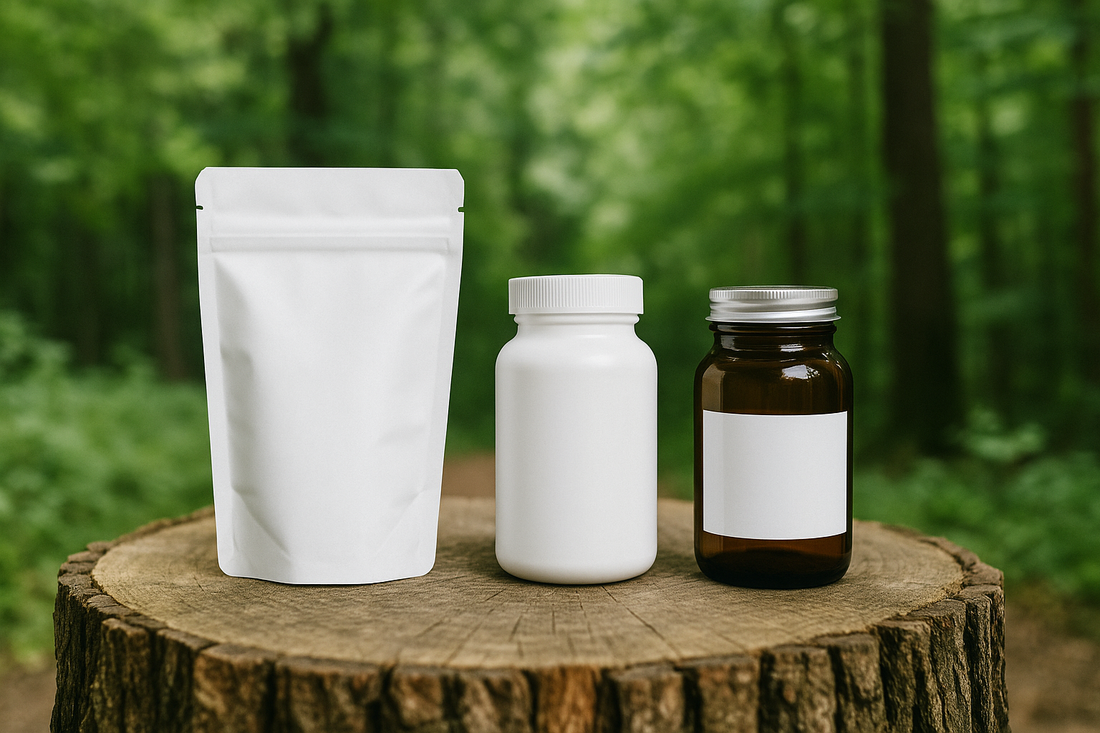
Which Packaging Has the Lowest Carbon Footprint? KOYAH’s Comparison of Jars vs. Pouches
Share
While product quality is our main focus at KOYAH, sustainability also plays a key role in guiding every decision we make—including how we package our organic supplements. To reduce our environmental footprint, we analyzed the full lifecycle impact of three packaging options for our 60-capsule products: HDPE plastic jars, glass jars, and matte stand-up pouches.
Comparing the Carbon Footprint of Each Package
We looked at each option across production, transportation, and disposal to determine total emissions (measured in kg CO₂e). Here’s how each format performs.
1. HDPE Plastic Jar (Recycled or Virgin)
Weight: 30g
Carbon Footprint: 0.10–0.155 (virgin); 0.055–0.105 (recycled)
- Production: Virgin HDPE generates high emissions (0.075–0.105); recycled HDPE lowers that to 0.04–0.075.
- Transportation: Lightweight, contributing only 0.01–0.02.
- Disposal: ~20% global recycling rate; landfill adds 0.015–0.03 (virgin) or 0.005–0.01 (recycled).
Pros: Lightweight, durable, cost-effective. Recycled HDPE supports circular material use.
Cons: Virgin HDPE has high emissions and poor global recycling outcomes.
2. Glass Jar (Recycled or Virgin)
Weight: 150g
Carbon Footprint: 0.144–0.31 (virgin); 0.105–0.175 (recycled)
- Production: Virgin glass is energy-intensive (0.099–0.225); recycled reduces that to 0.06–0.09.
- Transportation: High transport emissions due to weight (0.045–0.075).
- Disposal: ~60% recycling rate. Inert in landfills with minimal impact.
Pros: Reusable, recyclable, plastic-free, and excellent for capsule preservation.
Cons: Heavy, higher emissions, and prone to breakage in transit.
3. Matte Stand-Up Pouch (Non-Recyclable)
Weight: 6g
Carbon Footprint: 0.016–0.032
- Production: Low emissions from multilayer materials (0.012–0.024).
- Transportation: Minimal footprint due to ultra-light weight (0.001–0.002).
- Disposal: Not recyclable; landfilling adds 0.003–0.006.
Pros: Lowest total emissions. Compact, resealable, and highly space-efficient. Our matte stand-up pouch is ultra-lightweight and designed for maximum freshness and minimal emissions. Although it’s not recyclable or compostable, it uses significantly less material and results in much lower carbon emissions compared to rigid packaging options. While some may wonder about protection during shipping, we’ve seen very few cases of crushed capsules in our shipments to date.
Cons: Not compostable or recyclable with current materials. Slightly more flexible structure than jars.
Packaging Comparison Table
| Packaging Type | Weight | Carbon Footprint (kg CO₂e) | Advantages | Drawbacks |
|---|---|---|---|---|
| HDPE Jar | 30g | 0.10–0.155 (virgin) 0.055–0.105 (recycled) |
Durable, lightweight, partially recyclable | High emissions (virgin), limited recycled content |
| Glass Jar | 150g | 0.144–0.31 (virgin) 0.105–0.175 (recycled) |
Reusable, recyclable, plastic-free | Heavy, high transport emissions, breakable |
| Matte Pouch | 6g | 0.016–0.032 | Lowest emissions, ultra-lightweight | Non-recyclable, less rigid |
Why KOYAH Chooses the Matte Pouch
The matte stand-up pouch offers the lowest carbon footprint by a wide margin—up to 5× lower than recycled HDPE and 10× lower than virgin glass. Its compact, flexible form reduces emissions across production, shipping, and storage.
While some customers may be concerned about durability during shipping, our experience has shown the pouches to be protective and reliable—with very few cases of crushed capsules.
Moving Forward Together
At KOYAH, we're committed to sustainable packaging that minimizes impact without compromising quality. By choosing our organic supplements in low-emission matte pouches, you’re helping reduce waste and carbon—one capsule at a time.
Shop KOYAH SupplementsNet Orders Checkout
| Item | Price | Qty | Total | |
|---|---|---|---|---|
| Subtotal |
$ 0.00 |
|||
| Shipping | ||||
| Total | ||||






